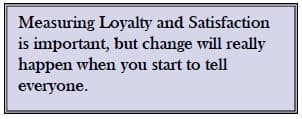CDE project 3 section 2: putting the principles and actions into practice — step 4 and 5
- Written by
- The Commission on the Donor Experience
- Added
- May 03, 2017
Step 4: Report what you find

It is really important to tell people:
- Why you are measuring how donors feel
- What specifically you are measuring
- The findings
In fact, the more people you tell, the more you will change your charity’s culture to one that truly understands donors’ needs, values them as individuals and encourages them support you as you seek to offer an ever-improving donor experience as well as raise money.
The critical thing isn’t just to tell people that you are doing it or even what you are doing. The critical thing is to tell them why you are targeting and measuring donor loyalty and satisfaction – that way, they will buy in to what you are doing.
Tell your fundraising team
In most charities, your fundraising team will be responsible for most of the communications that donors will see and receive. If they love their donors, they will support you and want to be involved. They should share ownership of the target and buy into the reasons for conducting this research. What they do will influence donors more than any other team.
Tell your communications team
If you have a separate Communications team, they should care just as much about how your donors feel as you do. Tell them about the excellent donor experience that you want to offer and the loyalty you want to create, and share the way you will measure success. That way, you will be far more likely to work together to create communications strategies that have the donor experience and donor loyalty at their heart.
Tell your CEO
Your CEO is the single most important person for developing your charity’s vision and culture. If you are to create a culture that truly values donors, then they will need to commit to it and understand how you are measuring improvements. They will need to lead the change that will make this happen.
Tell your Finance Director
Success is when your Finance Director comes to you and says that you should invest more in offering great donor experiences, because they have seen that this pays back in the long-term!
Tell your Trustees
Your Trustees are likely to move closer to your fundraising plans and techniques over the coming months. By sharing with them your plans for creating better donor experiences and the way you are measuring the resulting impact on donor satisfaction and loyalty, you will be helping them, and in turn they will help you.
Tell everyone!
In fact, donor satisfaction and loyalty is everyone’s job. Everyone should feel ownership of the target and responsibility to help achieve it.
Step 5: Change something
Change something in your fundraising. Measure the impact of this change and share the results of this test. Then learn from it and change something else.
Quick wins: Use what you have learnt to change something. Fast! Do you have a low score in your on-line giving process, the impact of your thank-you letters, the way you pick up the phone or perceptions of you newsletter? If so, test a different approach.
The bigger picture: Look at your overall donor experience (your asks, your engagement activities, your service and your feedback) to understand how you can grow emotional loyalty over time. Make changes to your supporter journey and measure the impact on the donors’ emotional loyalty as well as income.
Be a learning charity that strives for continual improvement.


















